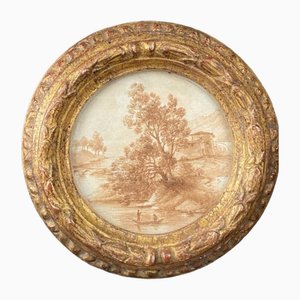French painter born in 1924, in Caudebec-les Elbeuf in Normandy, in a very modest family, sixth child of a family of thirteen children. At 14, he had to get to work and joined a local company as an apprentice painter. He lives rather miserably in Rouen and has the Salvation Army for shelter. He meets the painters Bordes, Le Trividic and Frechon who sympathize with him and give him advice. He is the last painter of Montmartre from the time of Maclet, Genin, Utrillo, Gen-Paul, and he has in his painting all the strength and the joy of the bohemian life of Montmartre.In 1947 he married and from this union was born a son whom he did not know until very late. Roland Dubuc, after having divorced, left for Le Havre where he met the painters Friboulet and Pailhes. He sells a few paintings at the Hamon gallery and lives from day to day, doing all kinds of jobs to survive: clown in a circus, newspaper seller, but always painting and trying to sell his paintings.In 1950, he decided to come and try his luck in Paris and continued to practice small jobs to live and to be able to paint. He met Michel Doddli who was a tailor at rue Victor-Massé at the time and later opened a gallery. M.Doddli will have it exhibited at the Grand Palais in the exhibition "The Great and the Young of Today". In 1958 he obtained the silver medal of the City of Paris with a painting entitled "The band of the firefighters of Montmartre".In 1960 Roland Dubuc remarried Edith Loisel, with whom he had two daughters. He then works at the hairdresser Antoine to make clay sculptures serve as a model. 1962, he exhibits sculptures at the Contemporary Gallery, rue de Châteaudun. In 1968, he separated from his wife and in 1972, he made his first exhibition, alone as a painter, at Jacqueline Laugier, rue Lepic in Montmartre. He moved to Switzerland where he exhibited in a gallery in Geneva. He sells a few paintings at the Petit Palais.In 1980, he returned to France and settled in Cherbourg with a doctor friend. In 1984, he returned to Paris and worked for the Pittiglio gallery for a while. At the end of 1985, one of his old friends Jean Paul Villain, who had been buying paintings from him for 20 years, opened a gallery at 29, rue de Miromesnil.He signs a worldwide exclusive contract with this gallery. It is for Roland Dubuc the painter, the beginning of success. His paintings are beginning to be sold in the U.S.A, Japan, Israel, Great Britain, Spain, Belgium, Switzerland...He died in his studio in Elbeuf in Normandy on February 27, 1998.
Peintre français né en 1924, à Caudebec-les Elbeuf en Normandie, dans une famille très modeste, sixième enfant d'une famille de treize enfants. À 14 ans, il doit se mettre au travail et entre dans une entreprise locale comme apprenti peintre. Il vit assez misérablement à Rouen et a pour refuge l'Armée du Salut. Il rencontre les peintres Bordes, Le Trividic et Frechon qui sympathisent avec lui et lui donnent des conseils. Il est le dernier peintre de Montmartre du temps de Maclet, Genin, Utrillo, Gen-Paul, et il a dans sa peinture toute la force et la joie de la vie de bohème montmartroise.En 1947 il se marie et de cette union naît un fils qu'il ne connaîtra que très tard. Roland Dubuc, après avoir divorcé, part pour Le Havre où il rencontre les peintres Friboulet et Pailhes. Il vend quelques tableaux à la galerie Hamon et vit au jour le jour en faisant toutes sortes de métiers pour survivre : clown dans un cirque, vendeur de journaux, mais toujours en peignant et en essayant de vendre ses tableaux.En 1950, il décide de venir tenter sa chance à Paris et continue à exercer des petits métiers pour vivre et pouvoir peindre. Il rencontre Michel Doddli qui est à l'époque tailleur rue Victor-Massé et qui ouvrira plus tard une galerie. M.Doddli le fera exposer au Grand Palais dans l'exposition "Les grands et les jeunes d'aujourd'hui". En 1958, il obtient la médaille d'argent de la Ville de Paris avec un tableau intitulé "La bande des pompiers de Montmartre".En 1960, Roland Dubuc se remarie avec Edith Loisel, avec qui il aura deux filles. Il travaille alors chez le coiffeur Antoine pour réaliser des sculptures en argile servant de modèle. en 1962, il expose des sculptures à la Galerie contemporaine, rue de Châteaudun. En 1968, il se sépare de sa femme et en 1972, il fait sa première exposition, seul en tant que peintre, chez Jacqueline Laugier, rue Lepic à Montmartre. Il s'installe en Suisse où il expose dans une galerie à Genève. Il vend quelques tableaux au Petit Palais.En 1980, il revient en France et s'installe à Cherbourg avec un ami médecin. En 1984, il revient à Paris et travaille quelque temps pour la galerie Pittiglio. Fin 1985, un de ses vieux amis Jean Paul Villain, qui lui achète des tableaux depuis 20 ans, ouvre une galerie au 29, rue de Miromesnil.Il signe avec cette galerie un contrat d'exclusivité mondiale. C'est pour Roland Dubuc le peintre, le début du succès. Ses tableaux commencent à être vendus aux Etats-Unis, au Japon, en Israël, en Grande-Bretagne, en Espagne, en Belgique, en Suisse... Il meurt dans son atelier d'Elbeuf en Normandie le 27 février 1998




Contactez-nous
Faire une offre
Nous avons remarqué que vous êtes nouveau sur Pamono !
Veuillez accepter les Termes, Conditions et Politique de Confidentialité
Contactez-nous
Faire une offre
Vous y êtes presque!
Pour suivre votre conversation sur la plateforme, merci de compléter votre enregistrement Pour procéder avec votre offre sur la plateforme, veuillez compléter l’enregistrement.Envoyé!
Merci pour votre message, un membre de notre équipe vous contactera rapidemment
Si vous etes un professionnel du design, merci de vous inscrire ici pour pouvoir profiter de bénéfices exclusifs